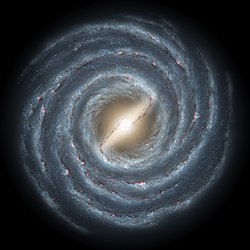Leo-V-Zwerggalaxie
| Galaxie Leo-V-Zwerggalaxie | |
|---|---|
| AladinLite | |
| Sternbild | Löwe |
| Position Äquinoktium: J2000.0, Epoche: J2000.0 | |
| Rektaszension | 11h 31m 9,6s[1] |
| Deklination | +02° 13′ 12″ [1] |
| Erscheinungsbild | |
| Morphologischer Typ | dSph [2] |
| Helligkeit (visuell) | (16,0 ± 0,4) mag [3] |
| Winkelausdehnung | (5,2 ± 1,2)′ [3] |
| Physikalische Daten | |
| Zugehörigkeit | Lokale Gruppe |
| Entfernung | 585.000 (570.000 ± 30.000) Lj / 180.000 (175.000 ± 9.000) pc [2][3] |
| Absolute Helligkeit | (−5,2 ± 0,4) mag |
| Geschichte | |
| Entdeckungsdatum | 2007 |
| Katalogbezeichnungen | |
| Leo V[1] | |
Die Leo-V-Zwerggalaxie, kurz auch Leo V, ist eine spheroidale Zwerggalaxie (dSph) im Sternbild des Löwen. Sie wurde im Jahr 2007 basierend auf den Daten des Sloan Digital Sky Survey entdeckt[2]. Die Galaxie liegt in einer Entfernung von etwa 180 kpc und entfernt sich von unserer Sonne mit einer Geschwindigkeit von rund 173 km/s[2]. Sie besitzt nahezu sphärische Form und hat einen Halblichtradius von näherungsweise 130 pc.[3]
Eigenschaften
Leo V ist eine der kleinsten und lichtschwächsten Trabanten der Milchstraße. Die integrale Leuchtkraft der Galaxie ist etwa 10.000-mal so groß wie diejenige der Sonne und beträgt in absoluter Helligkeit MV = (−5,2 ± 0,4) mag (andere Quellen nennen hier auch den Wert −4,3 mag und einen geringeren Halblichtradius von 40 pc, was weniger wäre als der eines typischen Kugelsternhaufens).[2][3]
Trotzdem beträgt die Masse von Leo V 330.000 Sonnenmassen, was zu einem Masse-Leuchtkraft-Verhältnis von 75 führt. Dieser relativ hohe Wert impliziert eine Dominanz durch Dunkle Materie für diese Galaxie.[4] Die Sternpopulation der Zwerggalaxie besteht hauptsächlich aus alten Sternen, die sich vor mehr als 12 Milliarden Jahren gebildet haben.[2] Die Metallizität der Galaxie fällt entsprechend gering aus mit [Fe/H] ≈ −2.0 ± 0.2, d. h., sie besitzt, verglichen mit der Sonne, etwa ein Hundertstel an schweren Elementen.[4]
Leo V ist nur etwa 3 Grad entfernt von einer anderen Satellitengalaxie Leo IV unserer Milchstraße. Letztere liegt noch 20 kpc näher zur Sonne. Es existieren Hinweise, dass beide Galaxien physisch gekoppelt sind,[2] und Beweise für eine Verbindung durch stellare Ströme, einer Sternenbrücke.[3]
Einzelnachweise
- ↑ a b SIMBAD Astronomical Database. In: Results for Leo V Dwarf Spheroidal. Abgerufen am 4. Februar 2010.
- ↑ a b c d e f g V. Belokurov, Walker, M. G.; Evans, N. W. et al.: Leo V: A companion of a companion of the Milky Way galaxy. In: The Astrophysical Journal. 686, Nr. 2, 2008, S. L83–L86. arxiv:0807.2831. bibcode:2008ApJ...686L..83B. doi:10.1086/592962.
- ↑ a b c d e f De Jong, J. T. A.; Martin, N. F.; Rix, H. W.; Smith, K. W.; Jin, S.; MacCiò, A. V.: The Enigmatic Pair of Dwarf Galaxies Leo IV and Leo V: Coincidence or Common Origin?. In: The Astrophysical Journal. 710, Nr. 2, 2010, S. 1664. doi:10.1088/0004-637X/710/2/1664.
- ↑ a b M. G. Walker, Belokurov, V.; Evans, N. W. et al.: Leo V: Spectroscopy of a Distant and Disturbed Satellite. In: The Astrophysical Journal. 694, Nr. 2, 2009, S. L144–147. arxiv:0902.3003. bibcode:2009ApJ...694L.144W. doi:10.1088/0004-637X/694/2/L144.
Auf dieser Seite verwendete Medien
Caption from NASA: Like early explorers mapping the continents of our globe, astronomers are busy charting the spiral structure of our galaxy, the Milky Way. Using infrared images from NASA's Spitzer Space Telescope, scientists have discovered that the Milky Way's elegant spiral structure is dominated by just two arms wrapping off the ends of a central bar of stars. Previously, our galaxy was thought to possess four major arms.
This artist's concept illustrates the new view of the Milky Way, along with other findings presented at the 212th American Astronomical Society meeting in St. Louis, Mo. The galaxy's two major arms (Scutum-Centaurus and Perseus) can be seen attached to the ends of a thick central bar, while the two now-demoted minor arms (Norma and Sagittarius) are less distinct and located between the major arms. The major arms consist of the highest densities of both young and old stars; the minor arms are primarily filled with gas and pockets of star-forming activity.
The artist's concept also includes a new spiral arm, called the "Far-3 kiloparsec arm," discovered via a radio-telescope survey of gas in the Milky Way. This arm is shorter than the two major arms and lies along the bar of the galaxy.
Our sun lies near a small, partial arm called the Orion Arm, or Orion Spur, located between the Sagittarius and Perseus arms.Autor/Urheber: Copyright © 2003 Torsten Bronger., Lizenz: CC BY-SA 3.0
This is a celestial map of the constellation Leo, the Lion.




